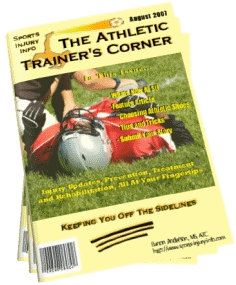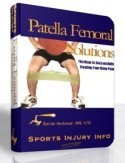ACL Rehab:
Regaining Range of Motion
Regaining your range of motion during ACL rehab is a major goal. It is often one of
the very first things that your clinician will focus on, along with
reducing pain and swelling.
These three things are
intimately tied together, and as each gets better, it helps to improve
the others.
What Causes Motion Loss?
Pain,
swelling, and the surgery itself all cause a loss of motion. With a
painful and swollen knee, range of motion is limited. This is
especially true for knee flexion. You can only bend your knee so far
before it starts to hurt, and it feels like it will explode.
Knee
extension is often limited by these factors as well as the inhibition
of the quadriceps muscles. Because the quads are not firing, you lack
the strength and control to extend your knee actively.
Improving Knee Flexion
Your
ACL rehab will consist of exercises to improve your range of motion.
The clinician who directs your rehab will provide you with exercises
that will help with this.
One very common exercise
to improve
knee flexion is a heel slide. It may also be called a towel pull. It is
a passive range of motion activity that helps to increase flexion.


To
perform a heel slide, you place a towel under your heel, grasping both
ends with your hands.
Relax your leg and pull the
towel and your heel
towards you, sliding your heel on the floor.
As
you flex your
knee, you will feel tightness and some discomfort. Unfortunately, this
is necessary.
If you do not push your knee into
ranges that cause some
discomfort, you will not make gains in your range of motion.
So
in this
case, no pain, no gain. Just don't overdo it. A little discomfort and
tightness is ok.
Another way your clinician may
increase your
flexion range of motion during ACL rehab is to have you lay on your
back with your foot up on the wall, and let your foot slide
down as your knee bends. This exercise uses gravity to
increase
your motion, and allows your quadriceps to relax.
Improving Knee Extension
After surgery, you should have full passive extension. Meaning your knee should straighten all the way out whe you relax your leg. You need to maintain this knee extension after surgery. It is one of the main goals during the first week of ACL rehab.Even with full passive knee extension, you won't be able to straighten it all the way out actively. This is because of the quadriceps weakness.
One way to improve quad function during ACL rehab is to use electrical muscle stimulation. This involves placing electrode pads on the quads, and then using a current to force the quads to contract. You also actively contract while the machine is on, and this improves your muscle control.
E-stim, as it is called, is not comfortable, and sometimes feels like a muscle cramp. You may also have pain around the incision when you contract the quads. This is normal.
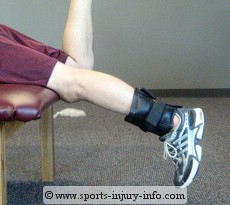
If you have lost passive extension, your clinician may have you perform prone hangs, or some other type of exercise to stretch the knee.
This is done by laying on your stomach and hanging your lower legs off of the table, letting the knee straighten out. This is not a comfortable exercise, and you should try to maintain your knee motion after surgery to avoid having to do it! Trust me, it isn't fun.
Improving Patellar Motion
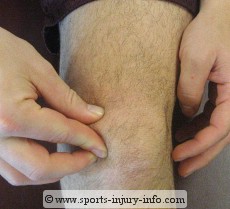
Movement
of the patella is essential when restoring range of motion during ACL
rehab. If the patella cannot move within the femoral groove, then the
knee cannot bend and extend.
You can work on
improving your
patellar mobility after acl reconstruction by simply pushing your
patella side to side and up and down. It won't feel good, but it will
help.
Compare how much your knee cap
moves on your uninjured leg with
your injured leg. You should work to get them moving evenly.
Because
of the surgery and all of the healing that is taking place in the knee,
the patella has a tendency to get "stuck". All of the surrounding
tissues start to stick together, and this prevents the normal gliding
of the patella. Performing self patella mobilizations will help prevent
this.
Friction Massage to Improve Motion
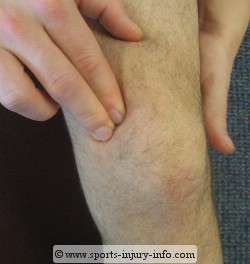
The anterior knee is very susceptible to adhesions and buildup of fluid and scar tissue.
This will limit motion both in flexion and extension. One way to combat
this is with friction massage.
Think about the
tissue in the
front of the knee as hundreds of layers. Each layer is independent of
the others, and must be able to easily glide and slide over the other
layers. After surgery, the layers will start to sick together, and they
can no longer slide over each other.
By applying
friction
massage to the area, you break up these adhesions, and allow the
tissues to slide past each other during knee motion. It is just one
more thing that doesn't feel very good, but helps tremendously.
ACL Surgery Stories
If you have had an ACL reconstruction, or are getting ready for this surgery, I want to hear your story. Whether you have questions you want answered, or just want to share your experience, this is the place for you.
Summary
Improving range of motion during ACL rehab is a major goal, especially in the first few weeks. You can help speed the process along by working on your motion at home. Make sure that your clinician address scar formation in the front of the knee, as well as patellar mobility.
Didn't find what you were looking for? Search SII for more information...Running Pain Solutions
Written for Runners by a runner, you'll learn a holistic approach to improving mobility, restoring normal movement and muscle activation patterns, and restoring the body and mind connection.
This Kindle Book contains a step by step program to keep you running pain free. Included are detailed instructions and illustrations for exercises to improve mobility, balance, neuromuscular control, strength and endurance. Only $7.49!
Get Your Copy Today!







